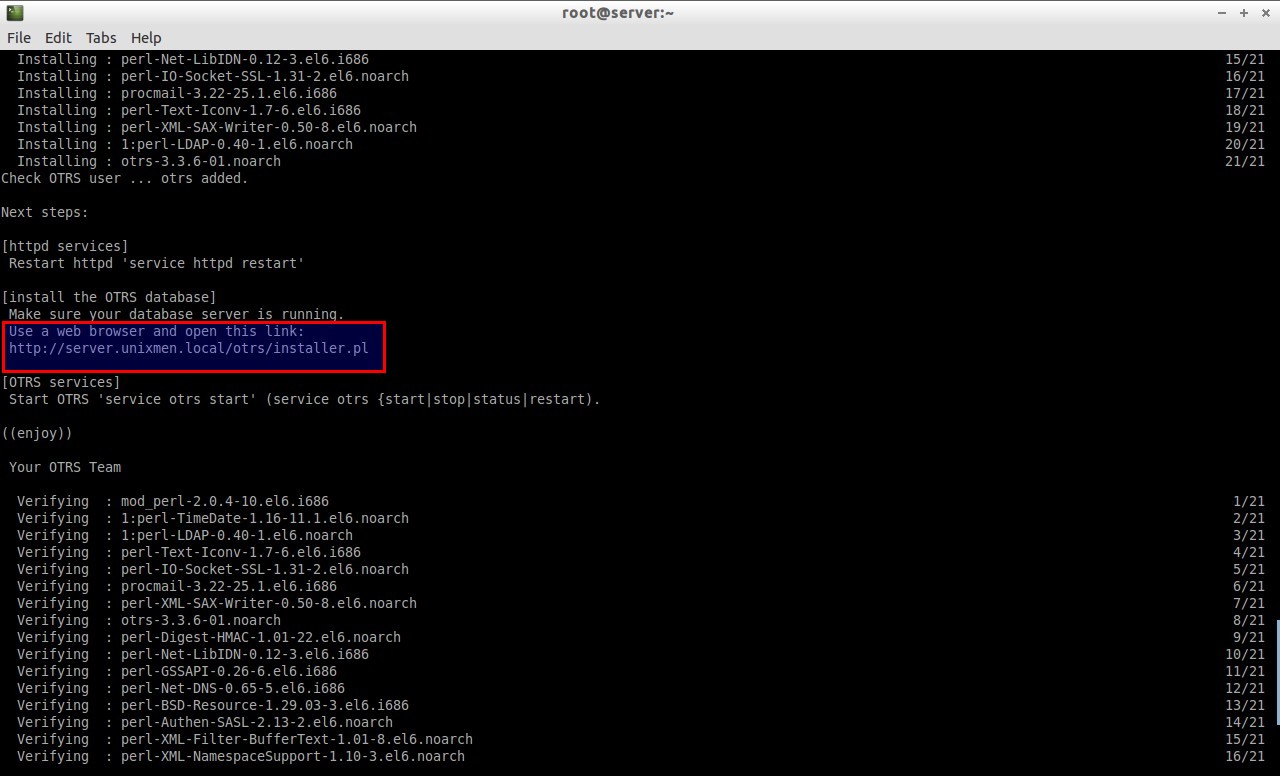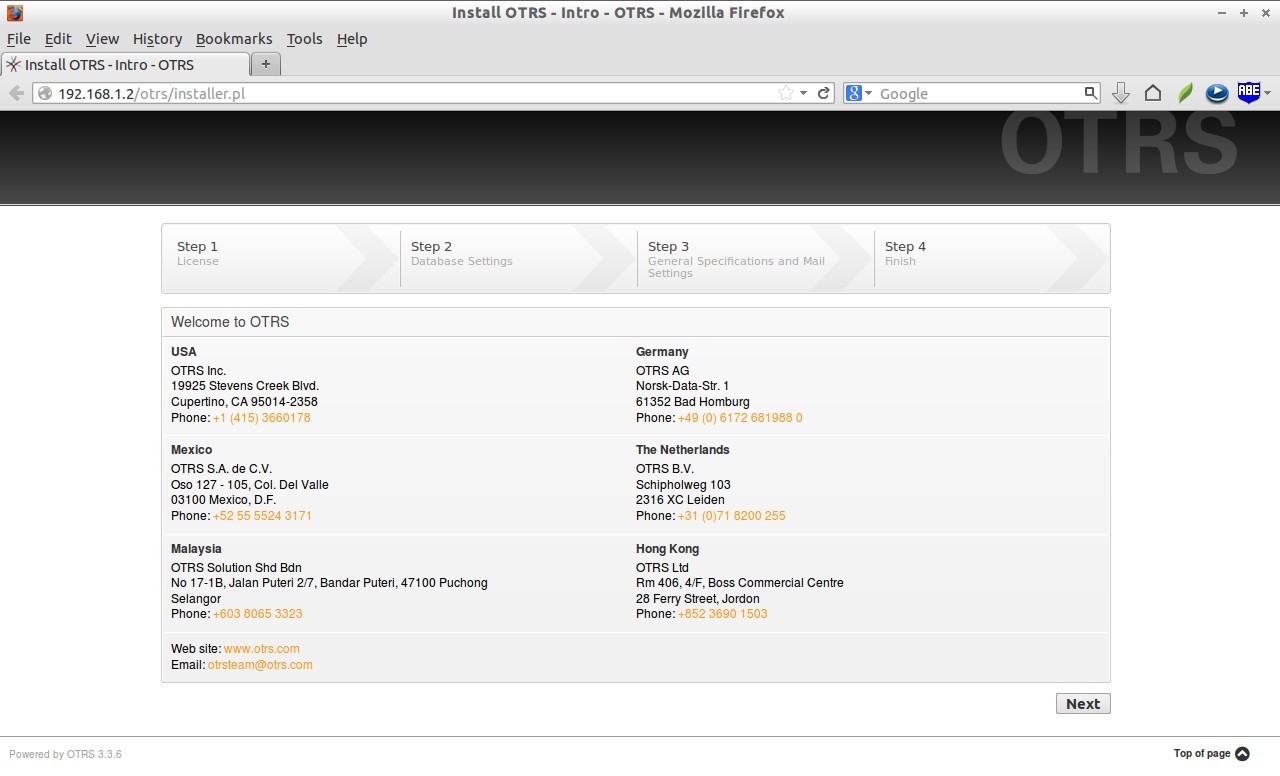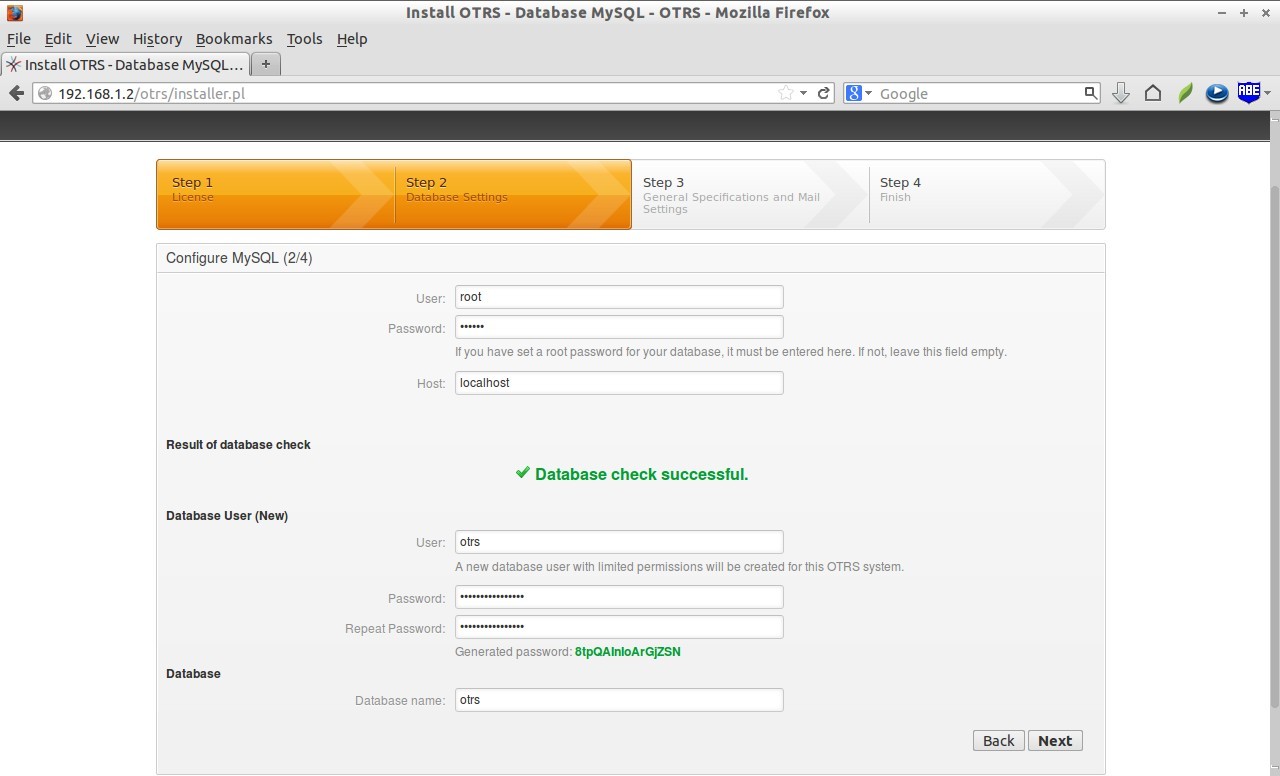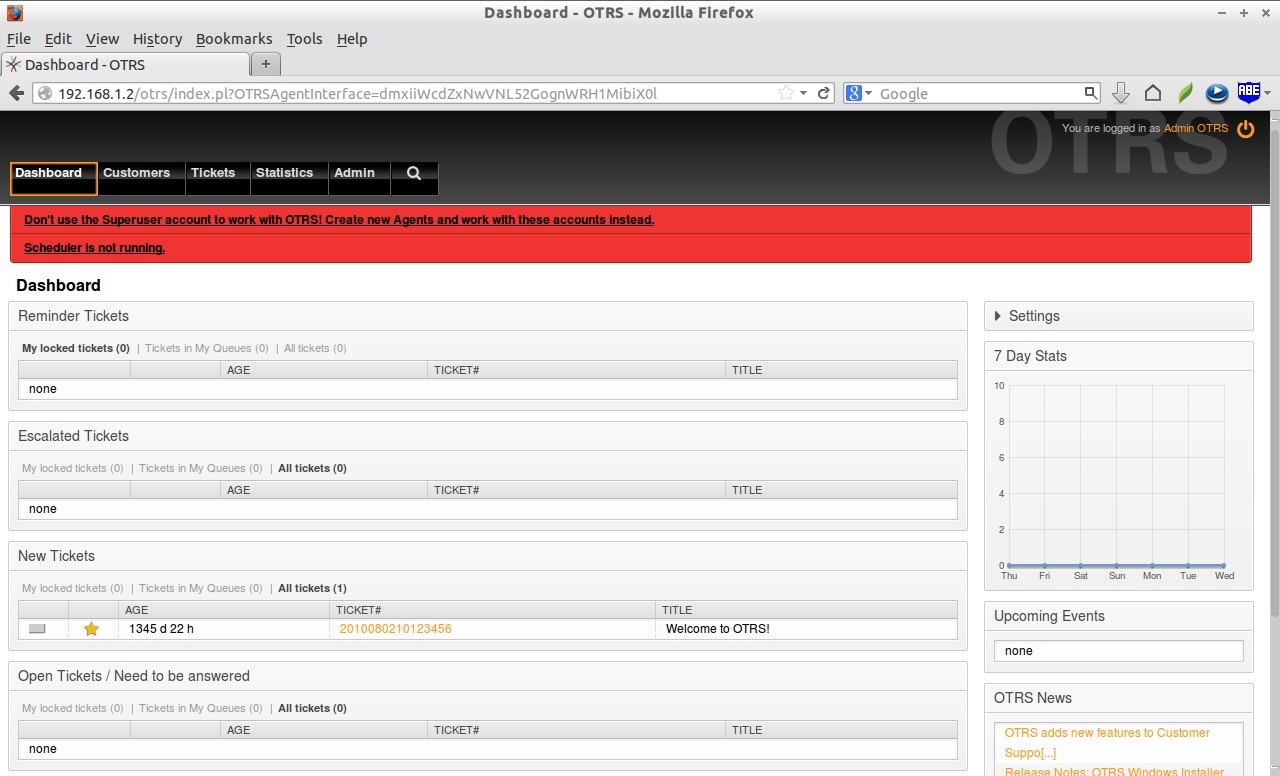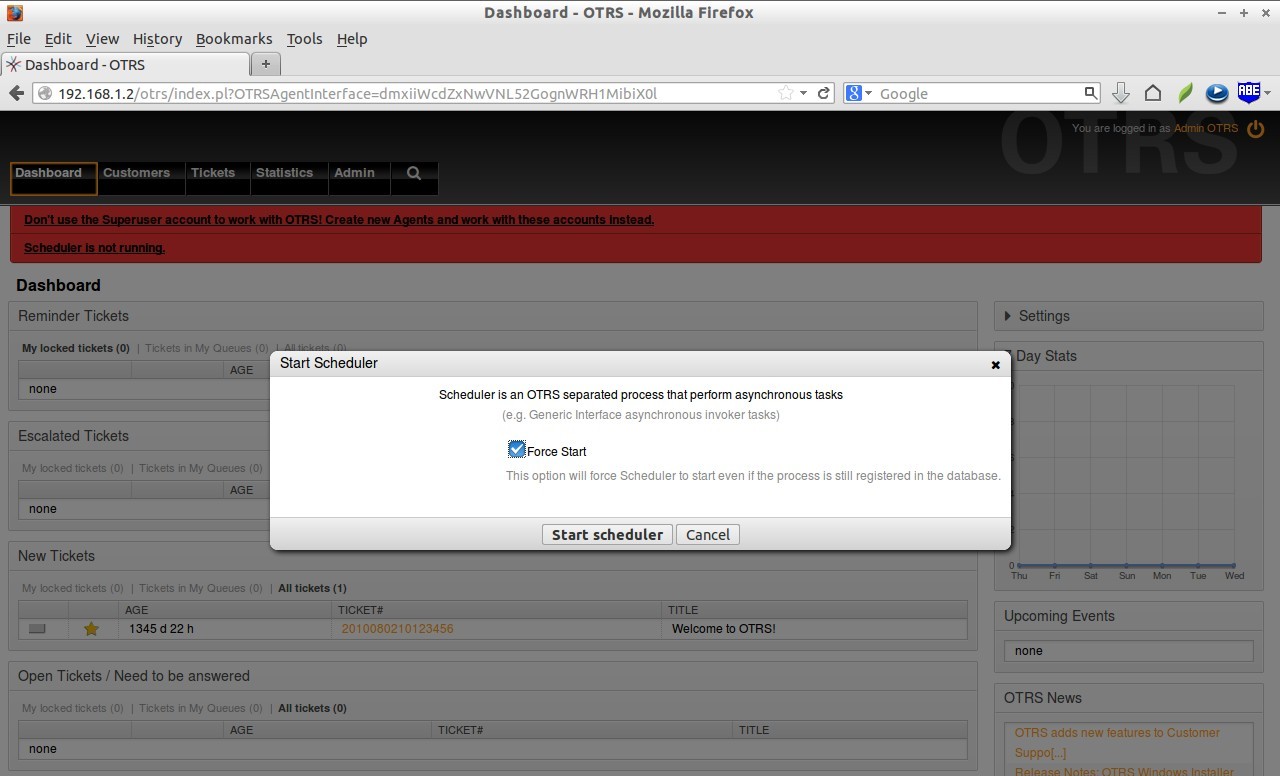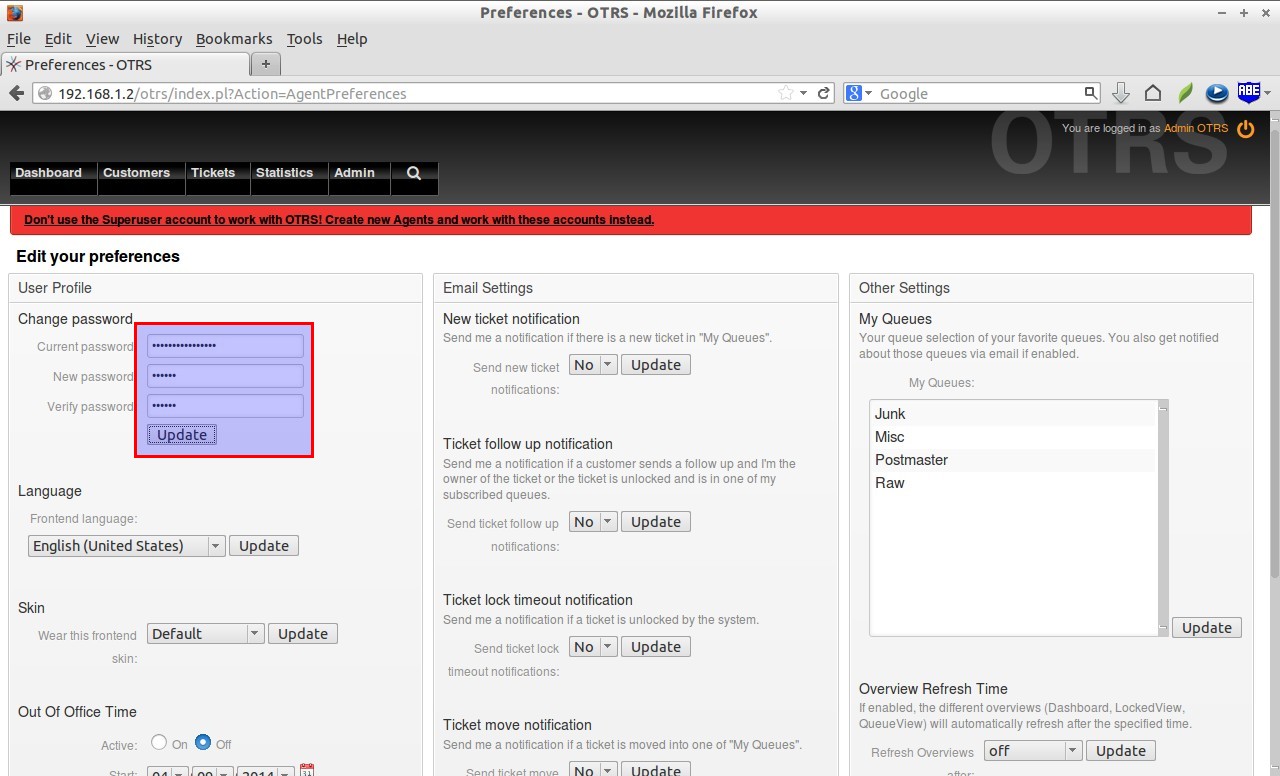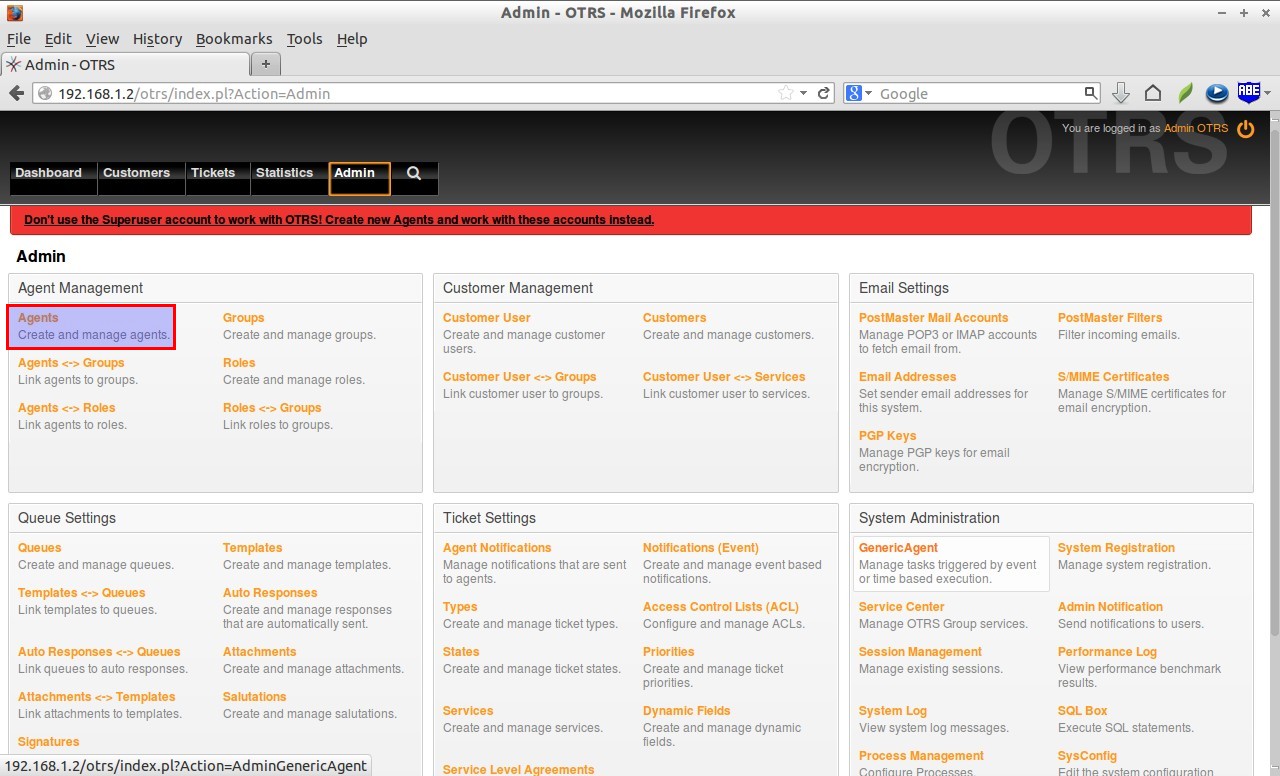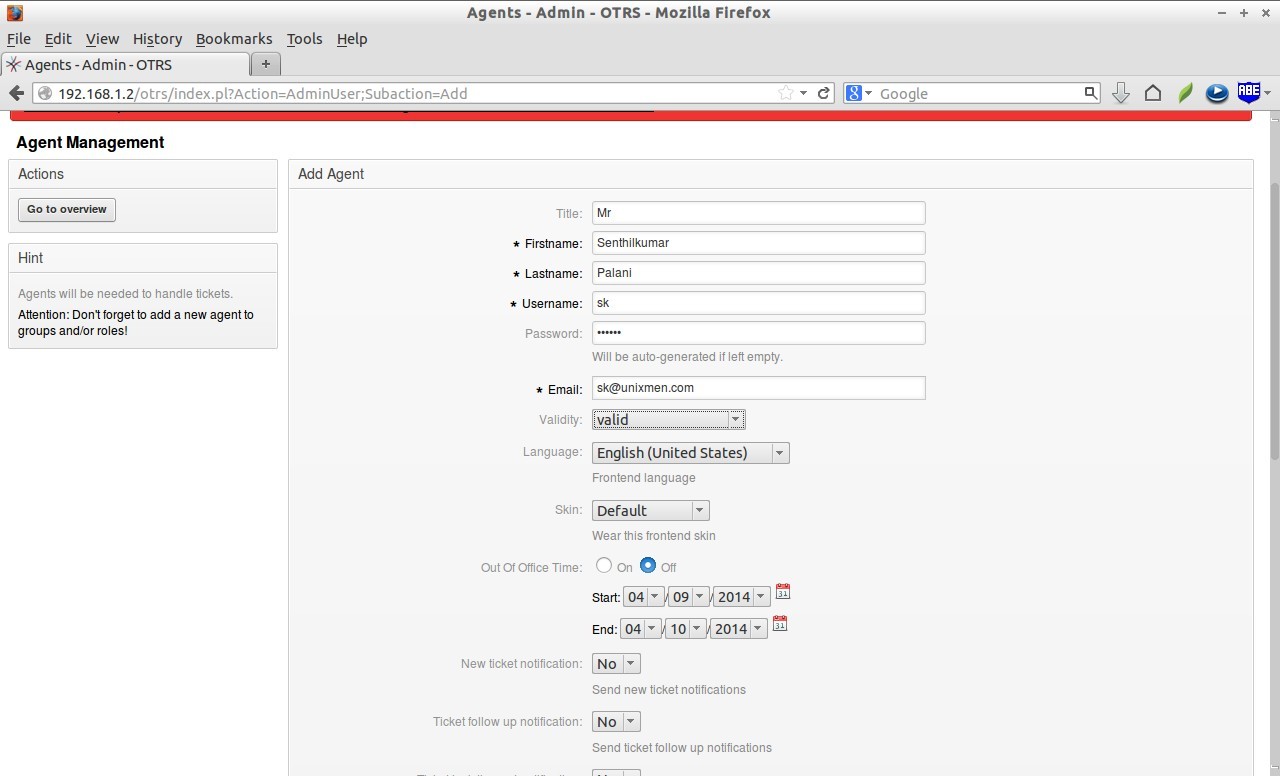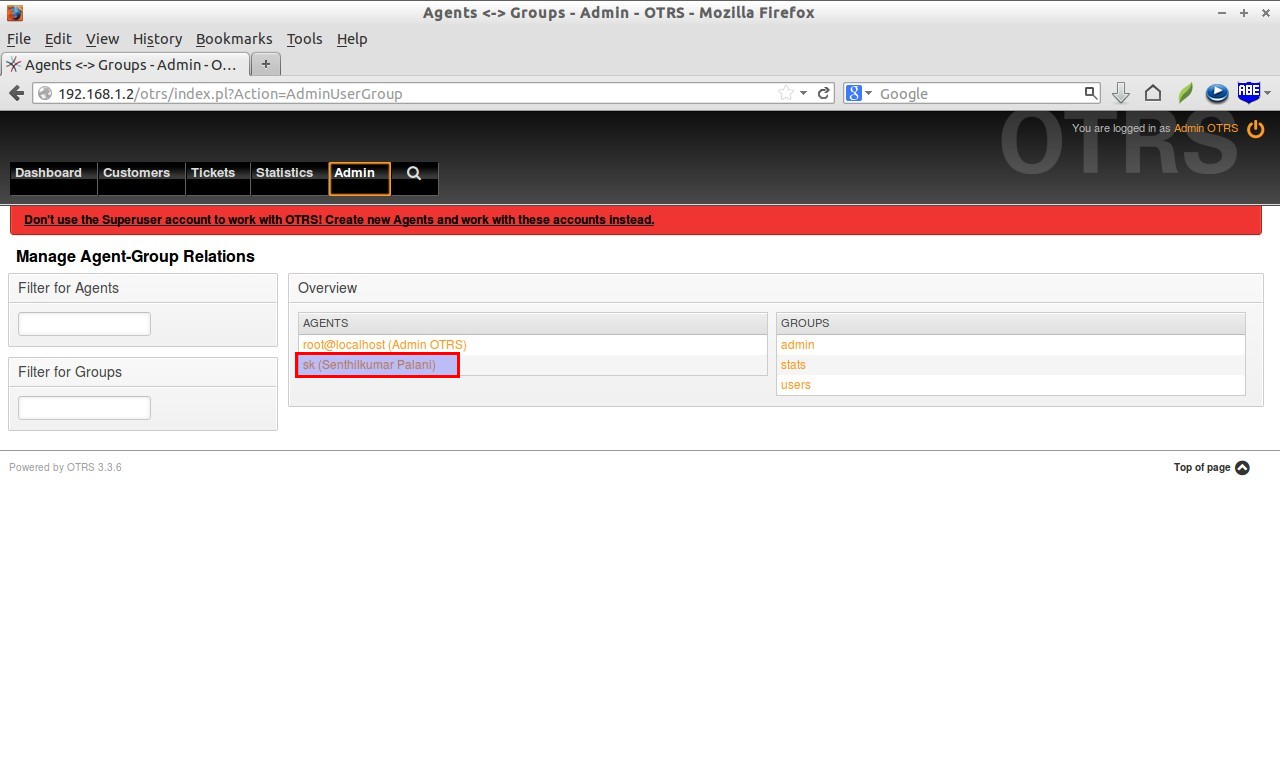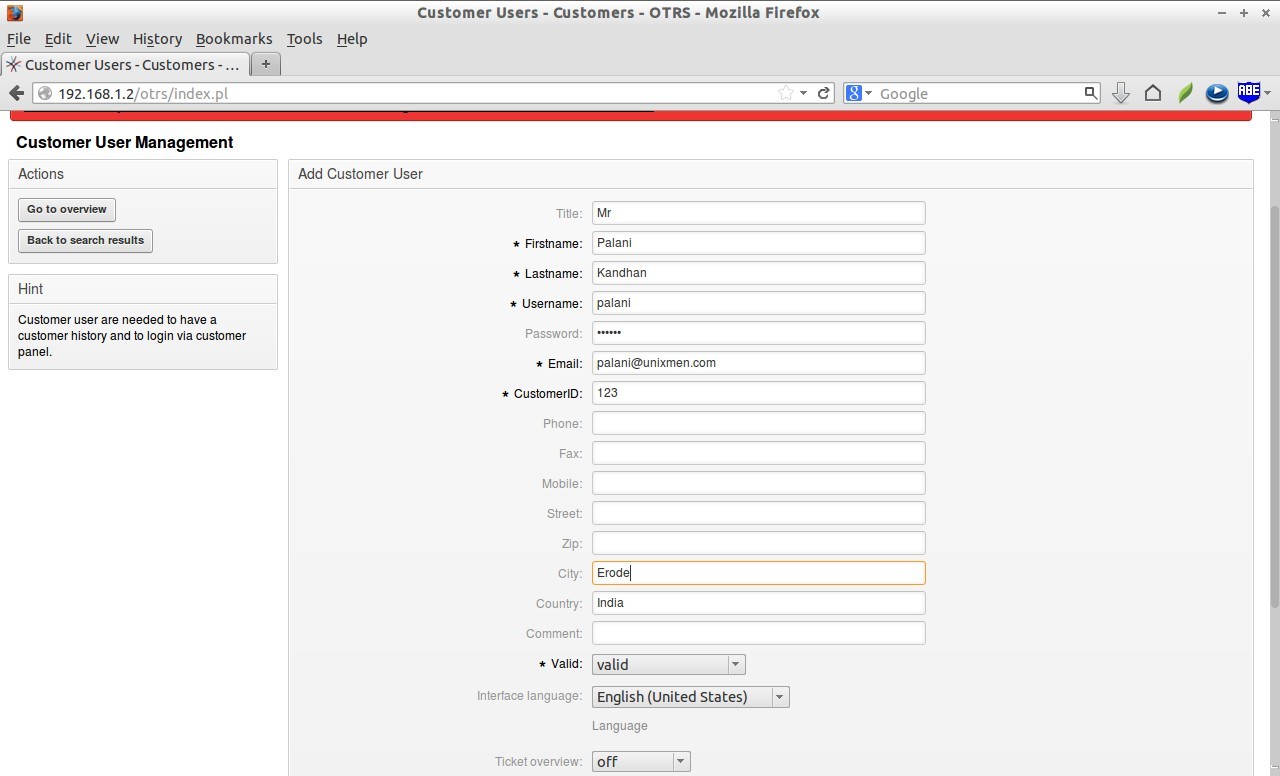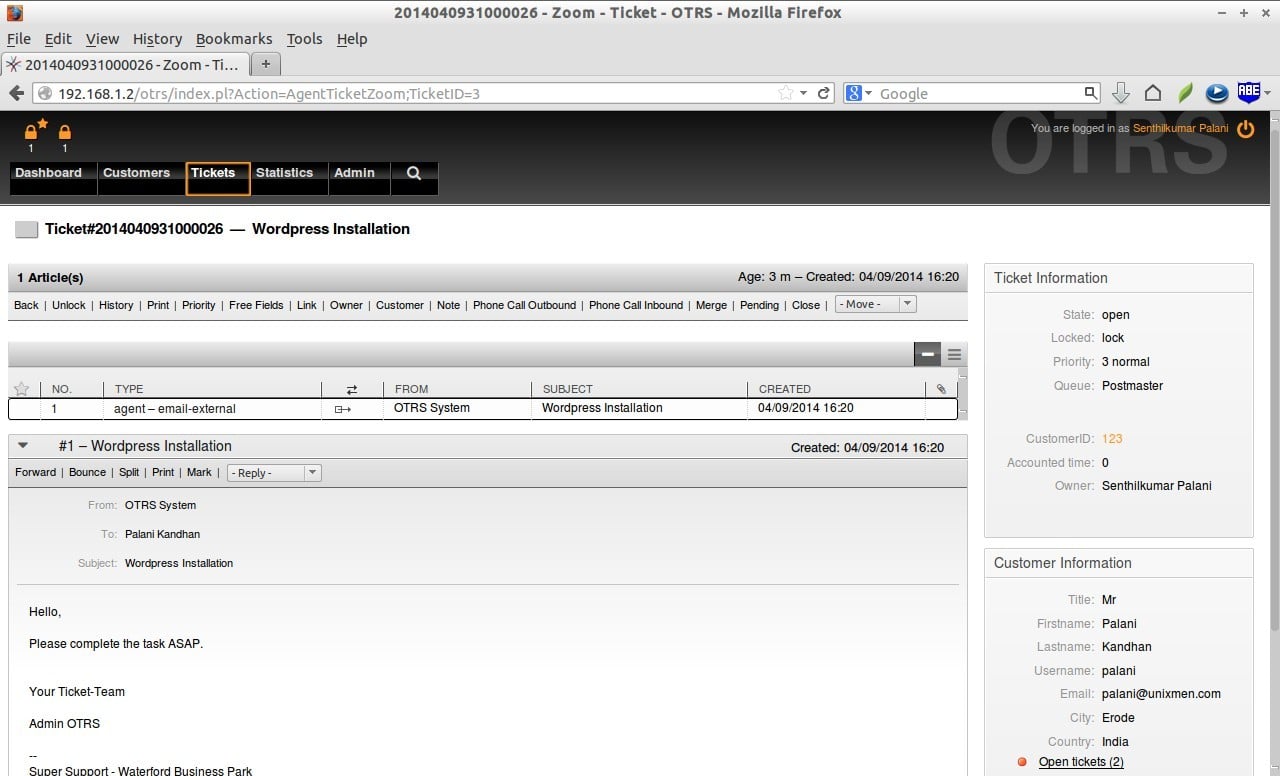Introduction
OTRS, stands for Open source Ticket Request System, is a popular help desk software that can be used to assign tickets to incoming queries, and tracks further communications when needed. using OTRS, we can manage incoming inquiries, complaints, support requests, defect reports, and other communications.
In this tutorial, let us see how to install OTRS latest version on CentOS 6.5. Here, my testbox details are given below:
- Operating System: CentOS 6.5 Minimal
- IP Address: 192.168.1.2/24
- Hostname: server.unixmen.local
Prerequisites
Before installing OTRS, we have to do couple of prerequisites first.
First, make sure you have configured the proper FQDN name in /etc/hosts file.
vi /etc/hosts
Set the hostname as shown below:
127.0.0.1 localhost localhost.localdomain localhost4 localhost4.localdomain4
::1 localhost localhost.localdomain localhost6 localhost6.localdomain6
192.168.1.2 server.unixmen.local server
Log off or restart the system to take effect the saved changes.
Install and enable EPEL repository.
Log in as root user and Install Mysql server using the following command:
yum install mysql-server
Start mysql service as shown below:
service mysqld start chkconfig mysqld on
By default, Mysql root user is blank. So let us setup the root user password as shown below:
mysql_secure_installation
NOTE: RUNNING ALL PARTS OF THIS SCRIPT IS RECOMMENDED FOR ALL MySQL SERVERS IN PRODUCTION USE! PLEASE READ EACH STEP CAREFULLY! In order to log into MySQL to secure it, we'll need the current password for the root user. If you've just installed MySQL, and you haven't set the root password yet, the password will be blank, so you should just press enter here. Enter current password for root (enter for none): -----> Press Enter OK, successfully used password, moving on... Setting the root password ensures that nobody can log into the MySQL root user without the proper authorisation. You already have a root password set, so you can safely answer 'n'. Change the root password? [Y/n] y -----> Enter Y and press Enter New password: -----> Enter the new password Re-enter new password: -----> Enter password again Password updated successfully! Reloading privilege tables.. ... Success! By default, a MySQL installation has an anonymous user, allowing anyone to log into MySQL without having to have a user account created for them. This is intended only for testing, and to make the installation go a bit smoother. You should remove them before moving into a production environment. Remove anonymous users? [Y/n] y -----> Press Enter ... Success! Normally, root should only be allowed to connect from 'localhost'. This ensures that someone cannot guess at the root password from the network. Disallow root login remotely? [Y/n] y -----> Press Enter ... Success! By default, MySQL comes with a database named 'test' that anyone can access. This is also intended only for testing, and should be removed before moving into a production environment. Remove test database and access to it? [Y/n] y -----> Press Enter - Dropping test database... ERROR 1008 (HY000) at line 1: Can't drop database 'test'; database doesn't exist ... Failed! Not critical, keep moving... - Removing privileges on test database... ... Success! Reloading the privilege tables will ensure that all changes made so far will take effect immediately. Reload privilege tables now? [Y/n] y -----> Press Enter ... Success! Cleaning up... All done! If you've completed all of the above steps, your MySQL installation should now be secure. Thanks for using MySQL!
MySQL has been installed successfully with default options. In order to work properly with OTRS, we have to add the following directives into the my.cnf file.
Edit file /etc/my.cnf,
vi /etc/my.cnf
Add the following lines under the [mysqld] section:
max_allowed_packet=20M query_cache_size=32M
Save and close the file.
Next, restart mysql service using the following command:
service mysqld restart
Next, Install httpd package with command:
yum install httpd
Start httpd service, and make it to start automatically on every reboot.
service httpd start chkconfig httpd on
Edit file /etc/httpd/conf/httpd.conf,
cp /etc/httpd/conf/httpd.conf /etc/httpd/conf/httpd.conf.bak vi /etc/httpd/conf/httpd.conf
Find the following lines and modify them as shown below:
ServerAdmin root@domain.com ServerName [hostname or IP address]:80 Listen IP-address-of-the-server:80
Example:
ServerAdmin root@unixmen.local ServerName 192.168.1.2:80 Listen 192.168.1.2:80
Save and close file. Restart httpd service.
service httpd restart
Edit file /etc/sysconfig/iptables,
vi /etc/sysconfig/iptables
Add the following line:
-A INPUT -p tcp -m state --state NEW -m tcp --dport 80 -j ACCEPT
Then, restart iptables to take effect the saved changes using the following command:
service iptables restart
Disable SELinux, otherwise you will get the following error:
If you want to use the installer, set the Kernel/Config.pm writable for the webserver user!
To disable SELinux, Edit file /etc/sysconfig/selinux,
vi /etc/sysconfig/selinux
Set value to disabled.
SELINUX=disabled
After that, reboot the system.
Download OTRS
Go to the OTRS download page and download the latest version.
wget http://ftp.otrs.org/pub/otrs/RPMS/rhel/6/otrs-3.3.6-01.noarch.rpm
The above will download and save the OTRS rpm file in the current directory. Install it using command:
yum install otrs-3.3.6-01.noarch.rpm
The above command will install otrs package along with all required packages.
Finally, restart httpd service one more time after installing OTRS.
service httpd restart
During OTRS installation, keep attention on the installer. It will display the web installer URL for OTRS.
Look at the following screenshot.
Install Additional PERL modules
Before proceeding to configure OTRS, you should install additional perl modules. Run the following command to know the required modules by OTRS:
/opt/otrs/bin/otrs.CheckModules.pl
Sample output:
o Crypt::Eksblowfish::Bcrypt.......Not installed! (optional - For strong password hashing.) o Crypt::SSLeay....................ok (v0.57) o Date::Format.....................ok (v2.22) o DBI..............................ok (v1.609) o DBD::mysql.......................ok (v4.013) o DBD::ODBC........................Not installed! (optional - Required to connect to a MS-SQL database.) o DBD::Oracle......................Not installed! (optional - Required to connect to a Oracle database.) o DBD::Pg..........................Not installed! (optional - Required to connect to a PostgreSQL database.) o Encode::HanExtra.................Not installed! (optional - Required to handle mails with several Chinese character sets.) o GD...............................Not installed! (optional - Required for stats.) o GD::Text.......................Not installed! (optional - Required for stats.) o GD::Graph......................Not installed! (optional - Required for stats.) o IO::Socket::SSL..................ok (v1.31) o JSON::XS.........................Not installed! (optional - Recommended for faster AJAX/JavaScript handling.) o List::Util::XS...................ok (v1.21) o LWP::UserAgent...................ok (v6.05) o Mail::IMAPClient.................Not installed! (optional - Required for IMAP TLS connections.) o IO::Socket::SSL................ok (v1.31) o ModPerl::Util....................ok (v2.000004) o Net::DNS.........................ok (v0.65) o Net::LDAP........................ok (v0.40) o Net::SSL.........................ok (v2.84) o PDF::API2........................Not installed! (optional - Required for PDF output.) o Compress::Zlib.................ok (v2.021) o Text::CSV_XS.....................Not installed! (optional - Recommended for faster CSV handling.) o Time::HiRes......................ok (v1.9721) o XML::Parser......................ok (v2.36) o YAML::XS.........................Not installed! (required - Please install this module - )
As you see in the above output, some perl modules are missing. Install them all at once or one by one as shown below.
yum install "perl(Crypt::Eksblowfish::Bcrypt)" "perl(DBD::ODBC)" "perl(DBD::Oracle)" "perl(DBD::Pg)" "perl(Encode::HanExtra)" "perl(GD)" "perl(GD::Text)" "perl(GD::Graph)" "perl(JSON::XS)" "perl(Mail::IMAPClient)" "perl(PDF::API2)" "perl(Text::CSV_XS)" "perl(YAML::XS)"
Now, check again for any missing modules.
/opt/otrs/bin/otrs.CheckModules.pl
Sample output:
o Crypt::Eksblowfish::Bcrypt.......ok (v0.009) o Crypt::SSLeay....................ok (v0.57) o Date::Format.....................ok (v2.22) o DBI..............................ok (v1.609) o DBD::mysql.......................ok (v4.013) o DBD::ODBC........................ok (v1.48) o DBD::Oracle......................Not installed! (optional - Required to connect to a Oracle database.) o DBD::Pg..........................ok (v2.15.1) o Encode::HanExtra.................ok (v0.23) o GD...............................ok (v2.44) o GD::Text.......................ok (v0.86) o GD::Graph......................ok (v1.44) o IO::Socket::SSL..................ok (v1.31) o JSON::XS.........................ok (v2.27) o List::Util::XS...................ok (v1.21) o LWP::UserAgent...................ok (v6.05) o Mail::IMAPClient.................ok (v3.34) o IO::Socket::SSL................ok (v1.31) o ModPerl::Util....................ok (v2.000004) o Net::DNS.........................ok (v0.65) o Net::LDAP........................ok (v0.40) o Net::SSL.........................ok (v2.84) o PDF::API2........................ok (v2.019) o Compress::Zlib.................ok (v2.021) o Text::CSV_XS.....................ok (v0.85) o Time::HiRes......................ok (v1.9721) o XML::Parser......................ok (v2.36) o YAML::XS.........................ok (v0.38)
If everything seems good, proceed to web installer.
Begin OTRS Web installer
OTRS development team has made a simple way web based installer to make the installation lot easier.
Open up the web browser and navigate to http://ip-address/otrs/installer.pl.
The following screen will appear. Click Next to continue.
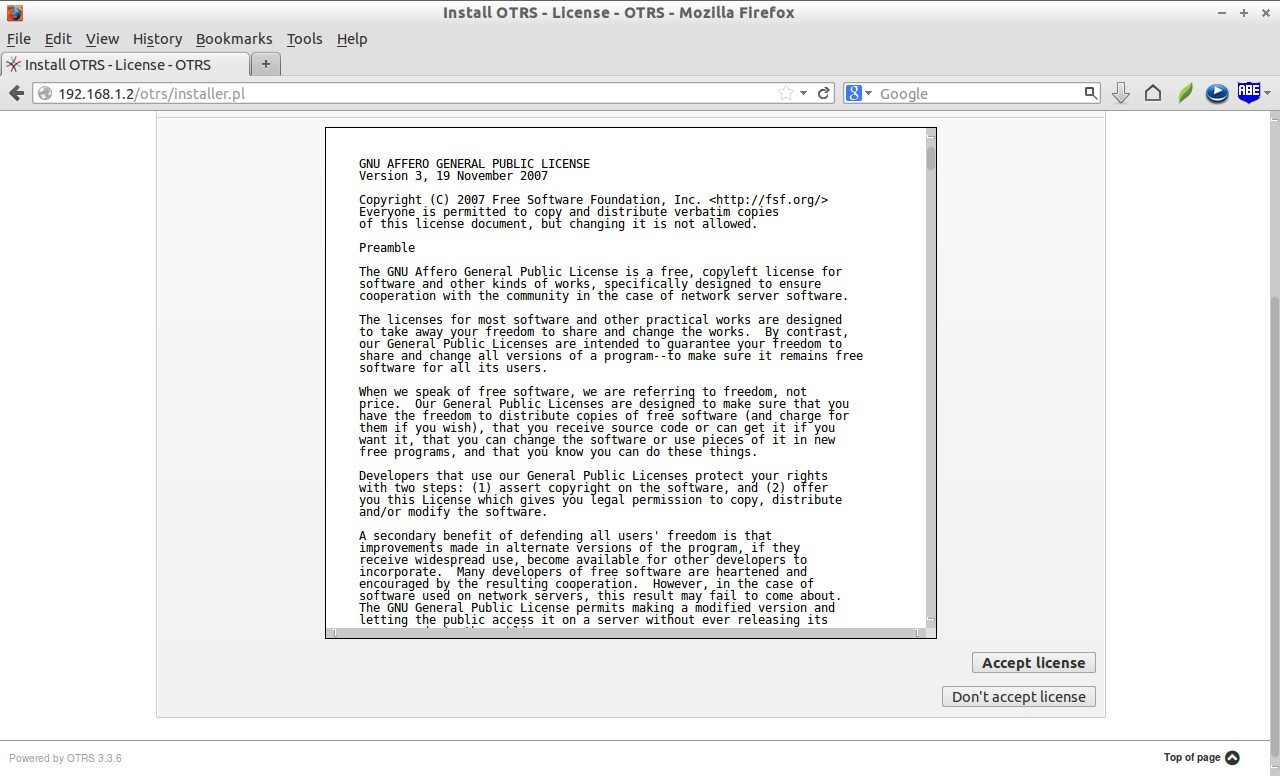
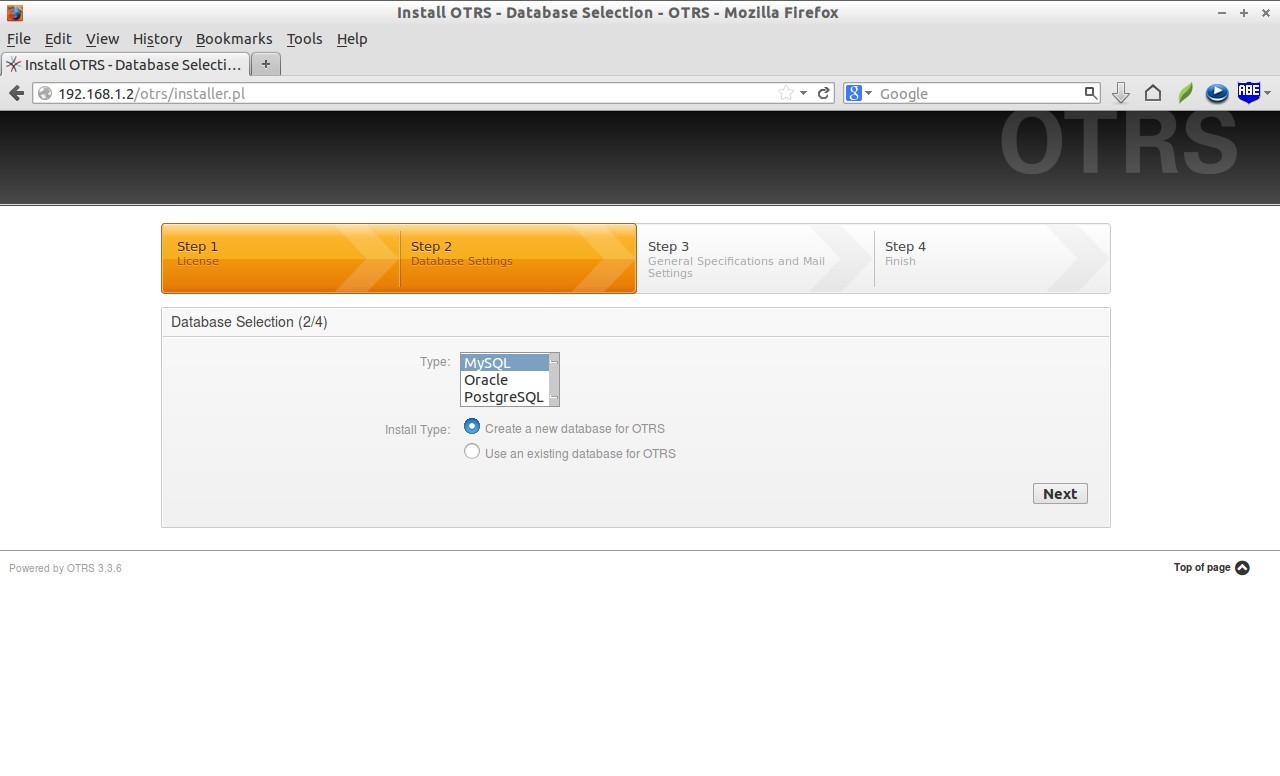
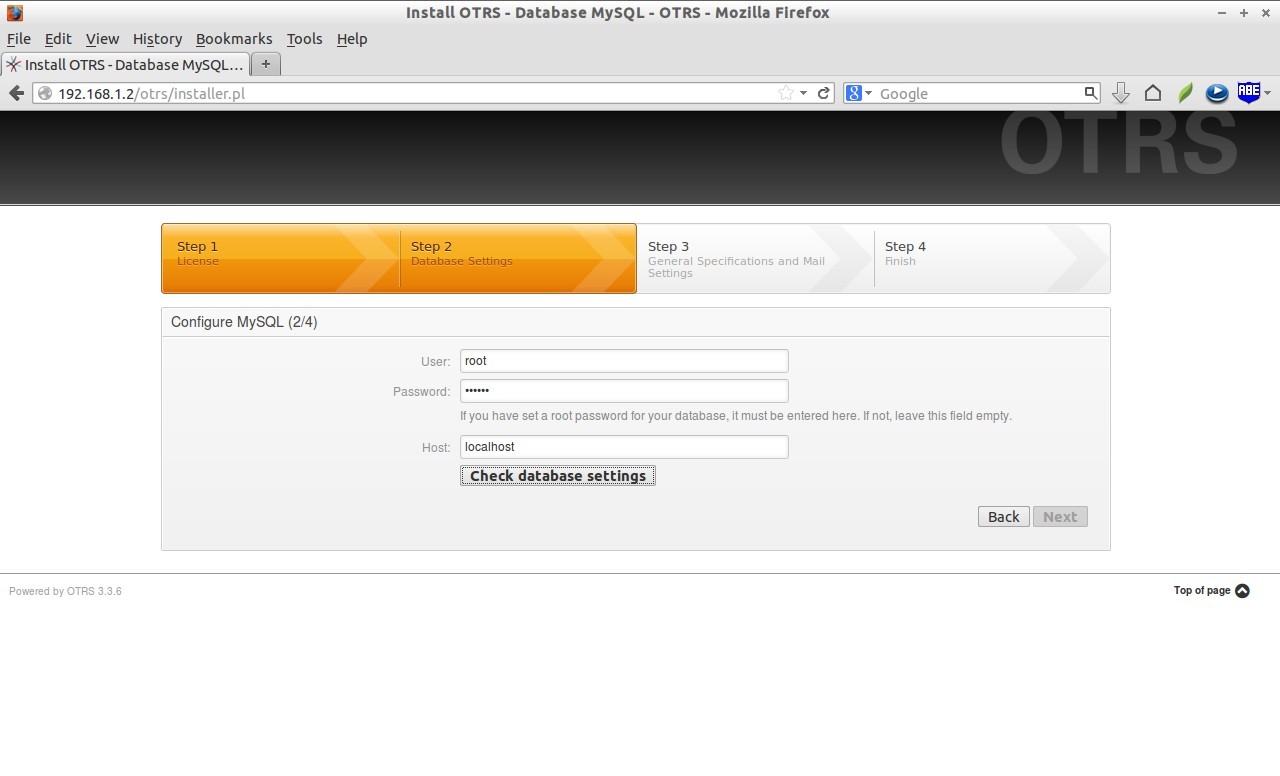
Now the new database will be created. Click Next to continue.
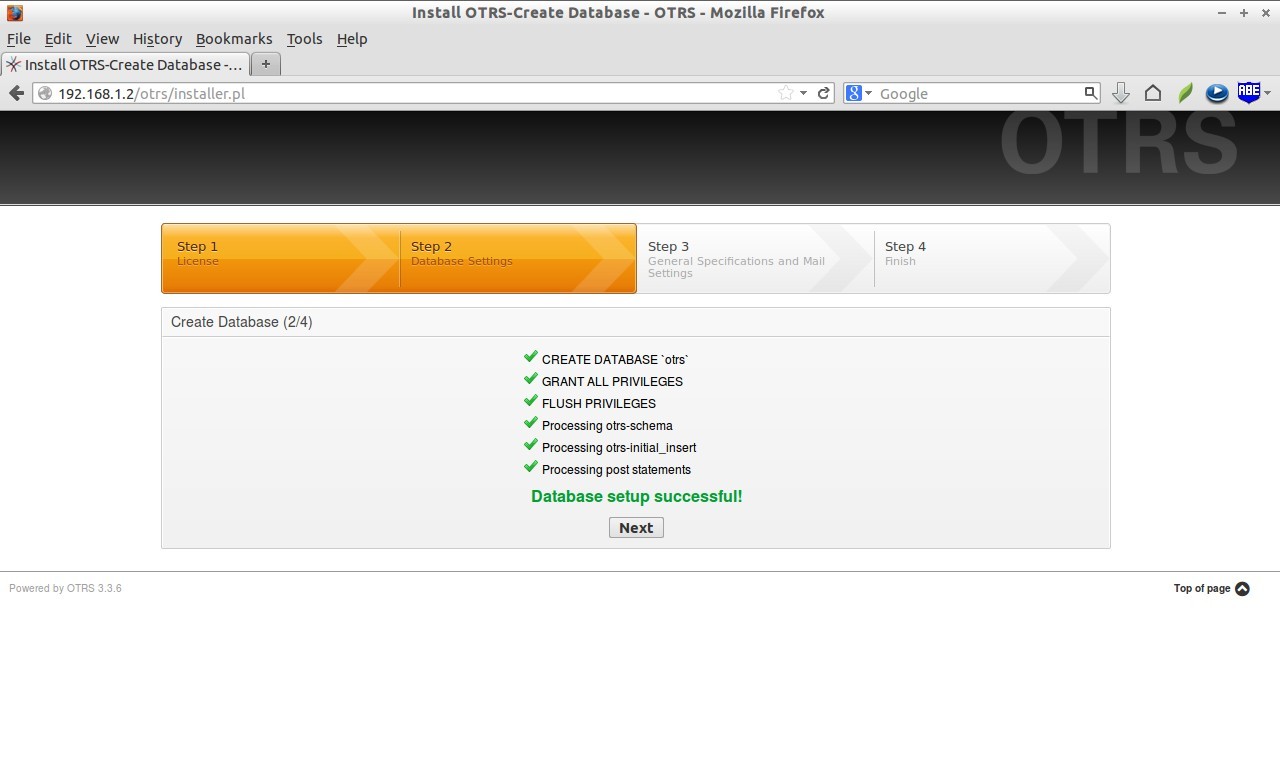
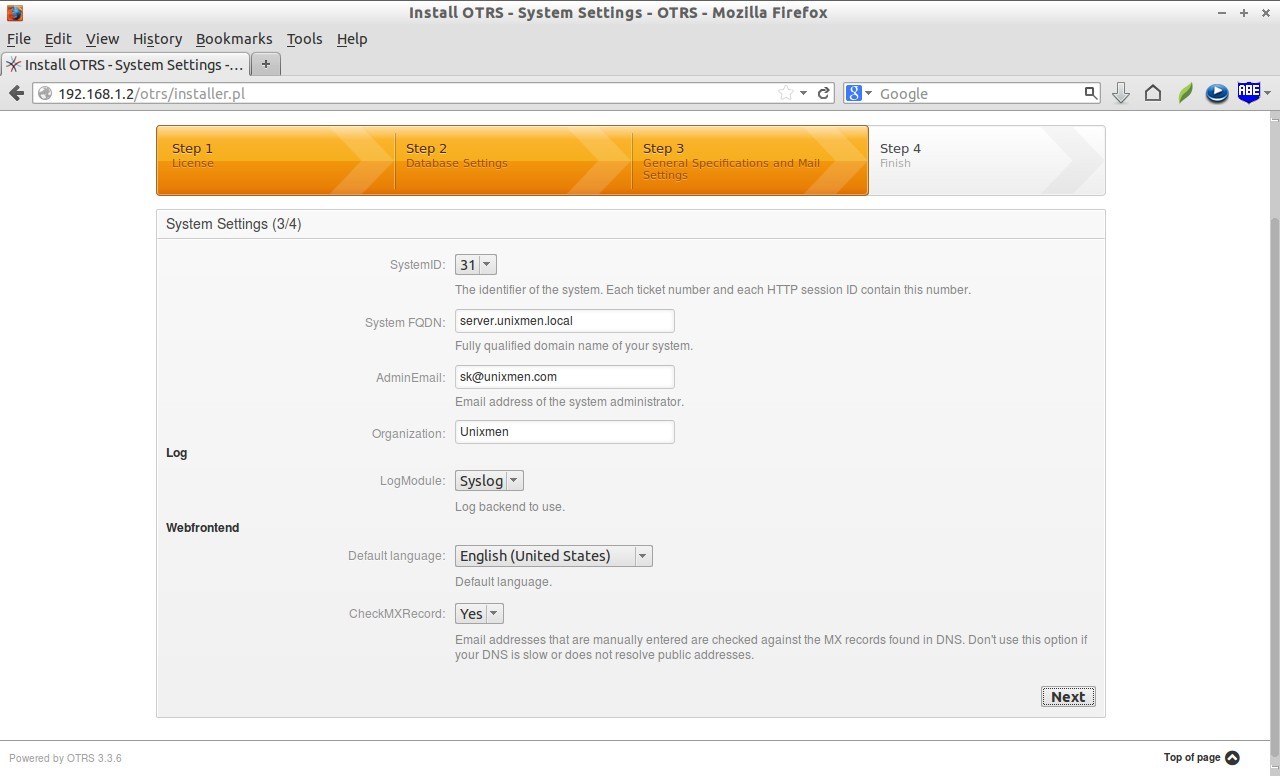
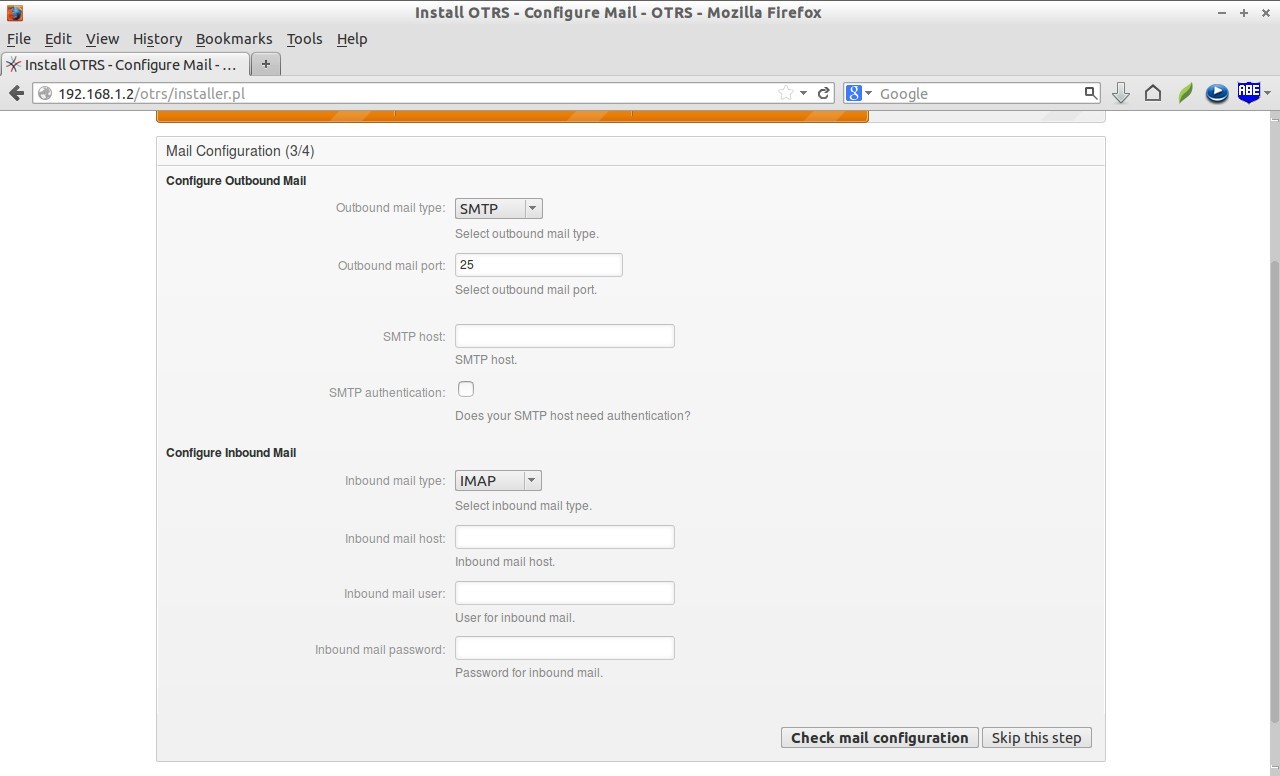
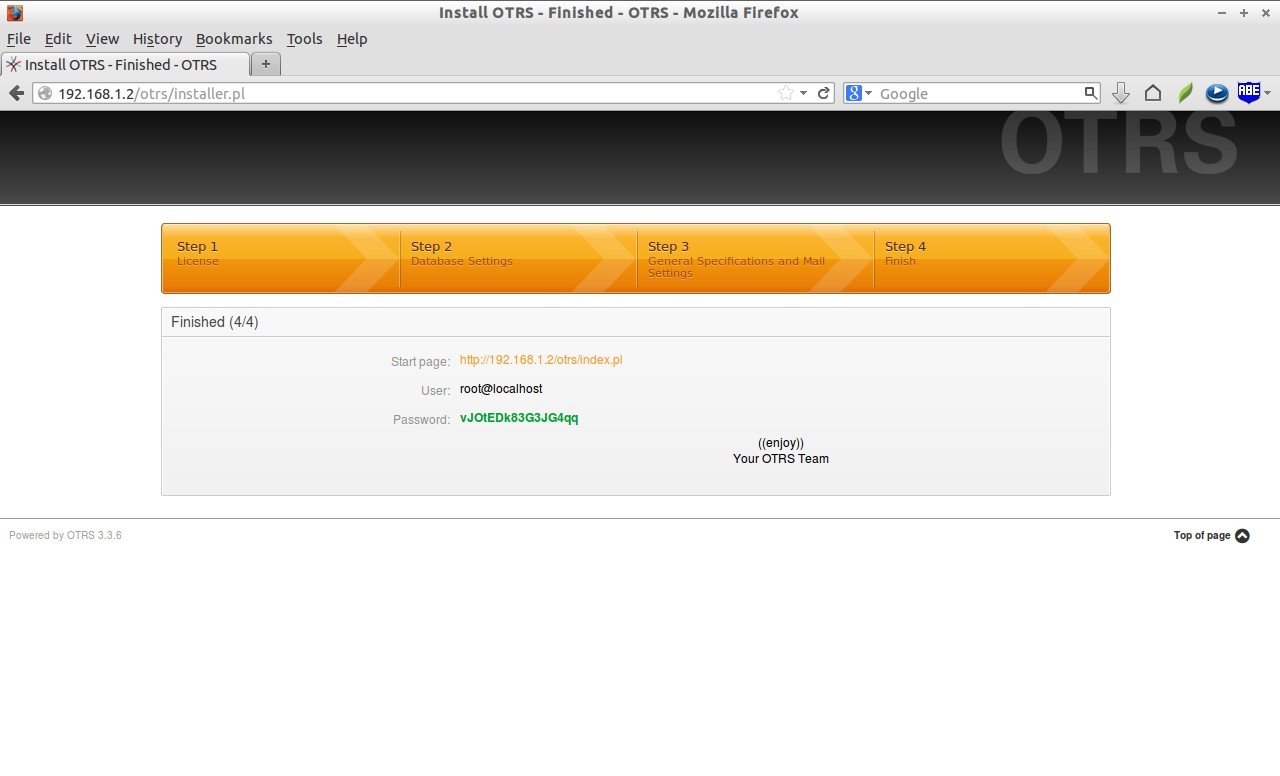
Access OTRS dashboard
Navigate to http://ip-address/otrs/otrs/index.pl from your browser. Enter the default user name and password.
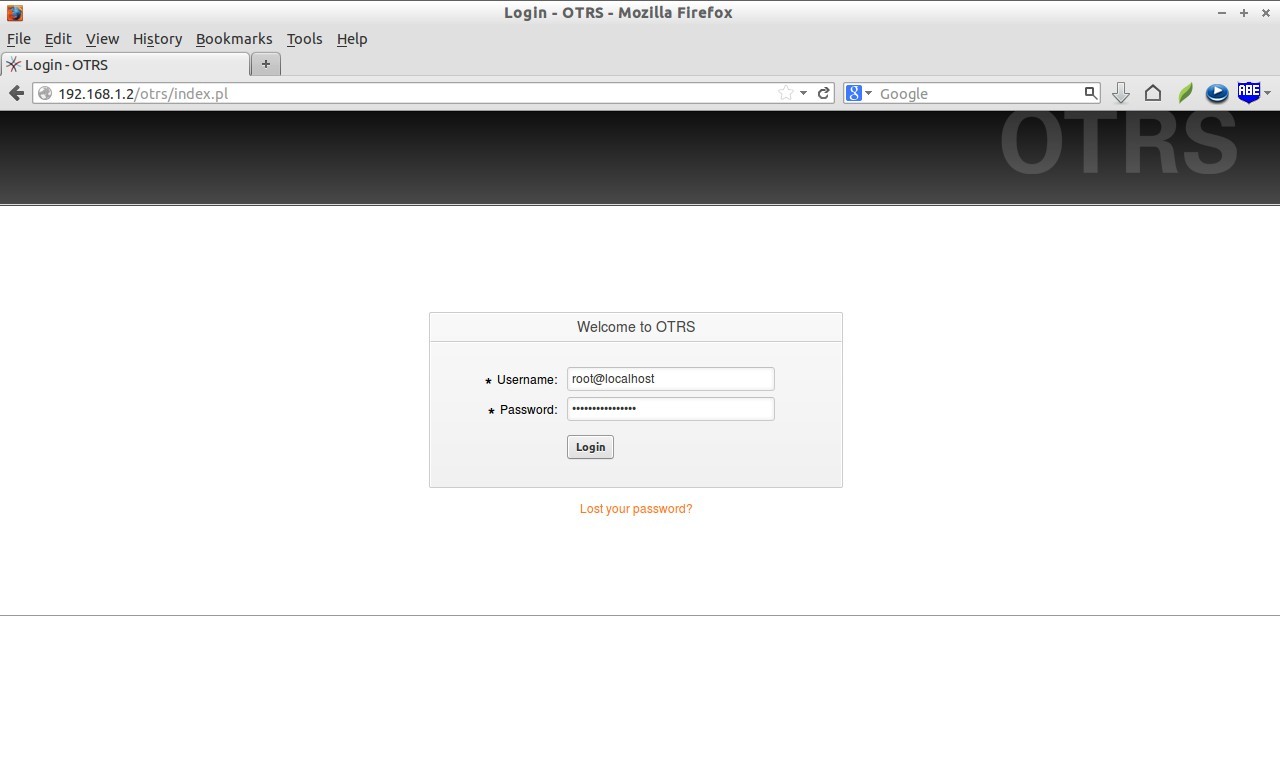
After successful installation, we have to do some installation tasks. The first one is to start the scheduler. Click on the warning link that says: “Scheduler is not running” on the top.
Click Start Scheduler button.
Next change the default password of the admin account(root@locahost) by clicking on the username on the upper top right corner.
Enter the current password, and enter the new password twice. Finally, click Update.
OTRS Administration
As you may know, working on OTRS with admin user is not recommended. So, create new users(agents).
Go to the Admin section on the top menu bar, and select Agents to create new user.
Click on the Add Agent Link on the left.
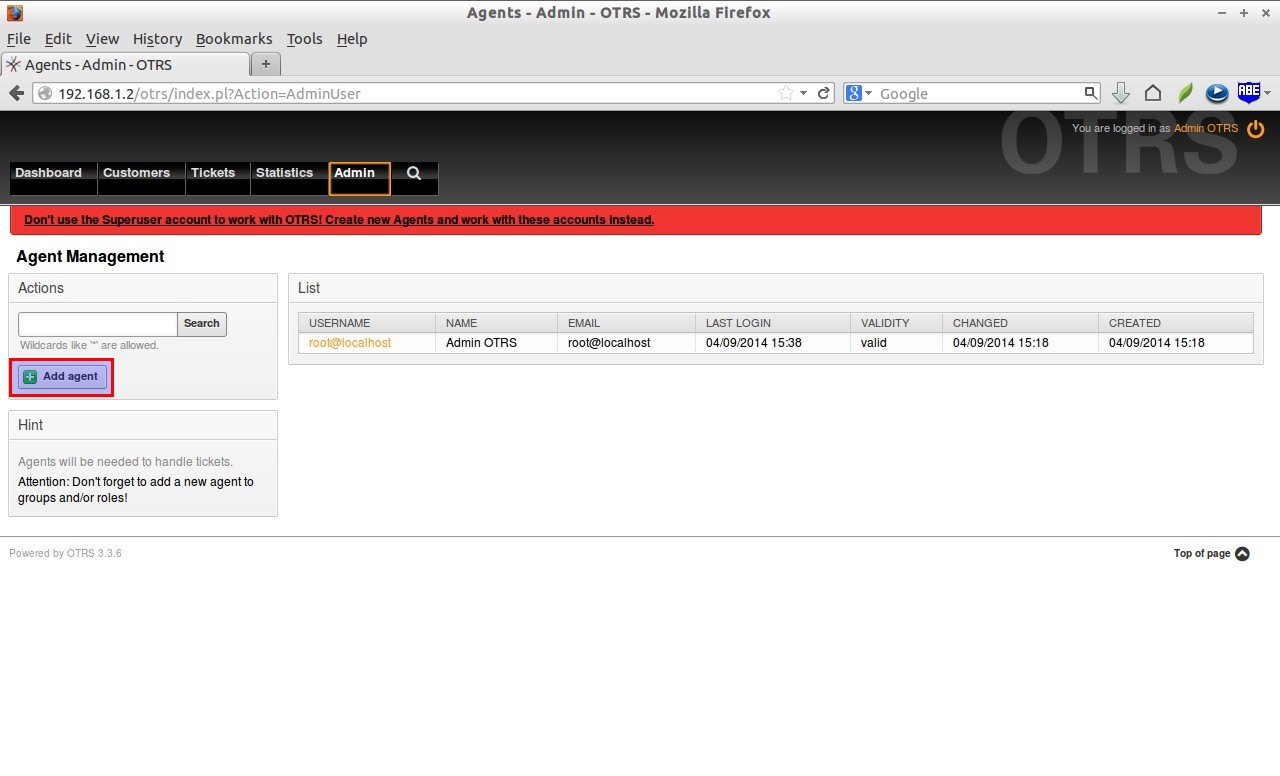
Next choose the group relations for the new agent. Then, click Submit button.
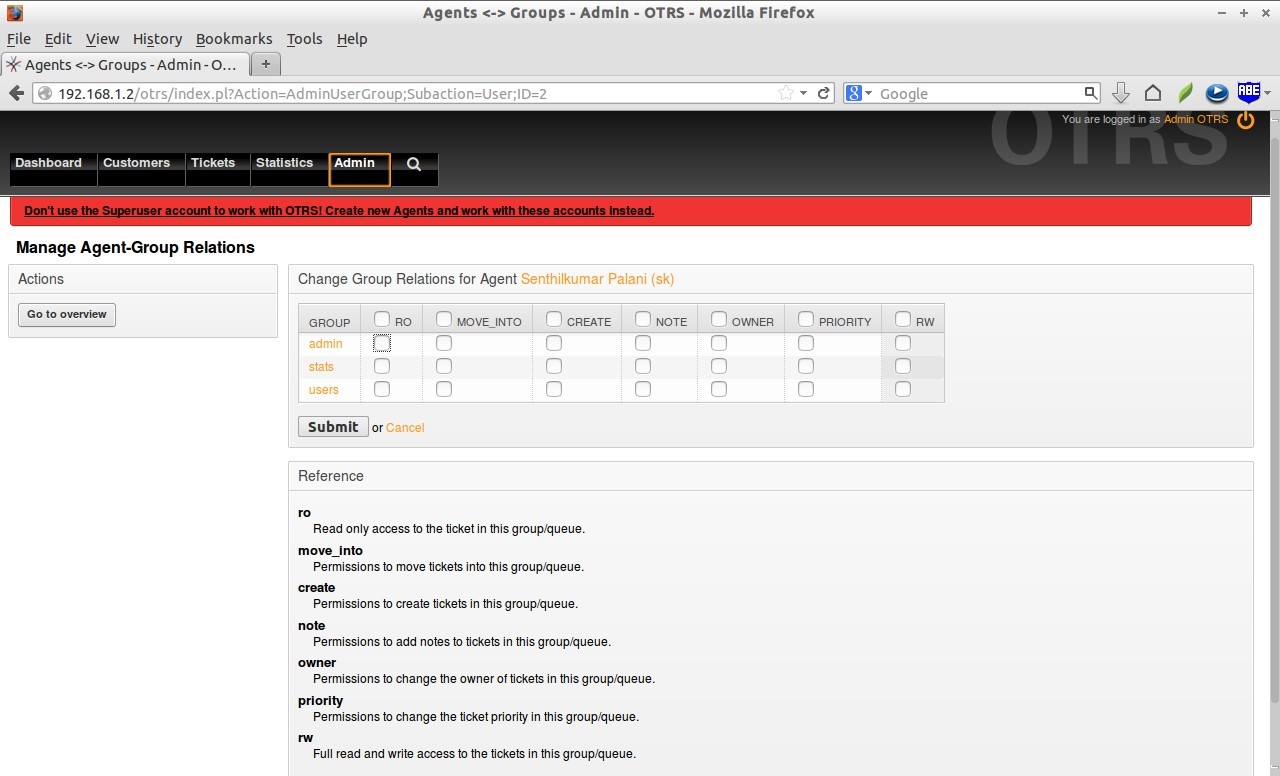
By this way, you create more users(agents), groups, roles, customers etc from the Admin section.
Customer user:
Create Tickets
Let us create a sample ticket, and assign this ticket to Agent sk. Navigate to Tickets -> New email ticket or Phone ticket.
Enter the customer user mail id, subject and body of the mail. Click on the Owner drop down box and select the Agent name. Finally, click Send mail. A new ticket will be created and assigned to the agent sk.
Sample Email ticket:
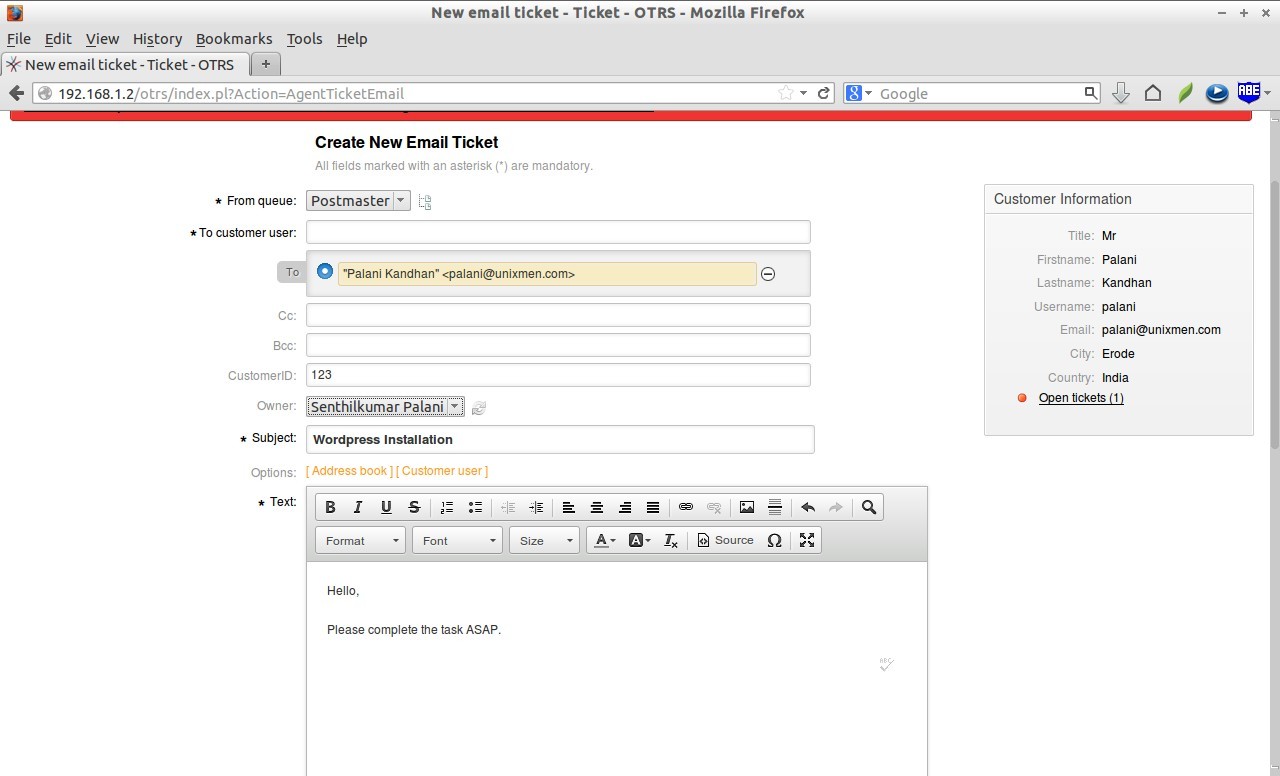
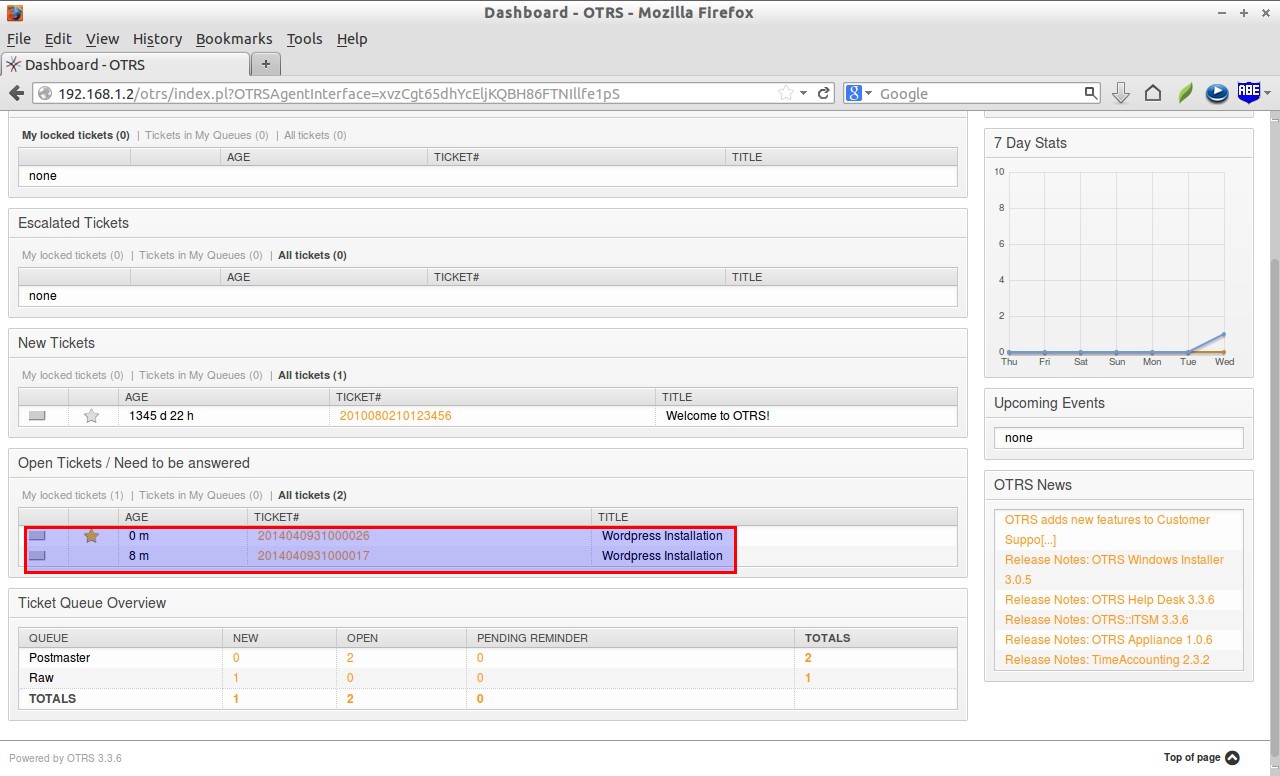
That’s it. For more details, look at the official documentation page.
Cheers!



